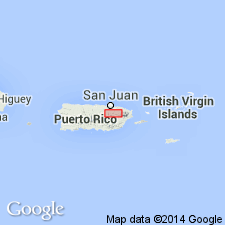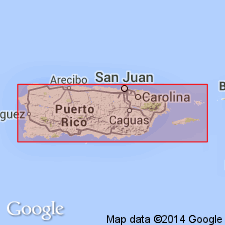
- Usage in publication:
-
- Carraizo Breccia*
- Modifications:
-
- Named
- Dominant lithology:
-
- Breccia
- Tuff
- AAPG geologic province:
-
- Caribbean region
Summary:
The Carraizo Breccia, here named, includes rocks previously mapped by Kaye (1959) as Hato Puerco Tuff in the Aguas Buenas quadrangle and is restricted to that quadrangle. Consists of greenish- to reddish-gray porphyritic lava fragments in a fragmental matrix. A tuffaceous siltstone member may represent a tongue of the Guaynabo Formation. Stratigraphic relation to other units is obscure because it is isolated by faults. Maximum thickness is at least 1,400 m. Age is Late Cretaceous.
Source: GNU records (USGS DDS-6; Reston GNULEX).

- Usage in publication:
-
- Carraizo Breccia*
- Modifications:
-
- Overview
- AAPG geologic province:
-
- Caribbean region
Summary:
The Carraizo Breccia occurs in eastern Puerto Rico and consists of pumiceous volcanic breccia and subordinate volcanic sandstone and tuffaceous siltstone and tuff. Minimum estimated thickness is 1400 meters. The Carraizo Breccia is of Late Cretaceous age.
Source: GNU records (USGS DDS-6; Reston GNULEX).
For more information, please contact Nancy Stamm, Geologic Names Committee Secretary.
Asterisk (*) indicates published by U.S. Geological Survey authors.
"No current usage" (†) implies that a name has been abandoned or has fallen into disuse. Former usage and, if known, replacement name given in parentheses ( ).
Slash (/) indicates name conflicts with nomenclatural guidelines (CSN, 1933; ACSN, 1961, 1970; NACSN, 1983, 2005, 2021). May be explained within brackets ([ ]).

